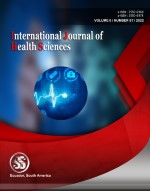Neonatal sepsis and associated maternal risk factors: A clinical case- control study
Keywords:
antibiotic therapy, bacteremia, bacterial infections, Neonatal sepsis, neonatal deathAbstract
Background: Neonatal sepsis is usually diagnosed with pathogen/bacterial isolation from the bloodstream or symptoms of infection seen in infection of 28 days or younger. Neonatal sepsis includes various diseases with varying mortality rates of 11-40% contributing to nearly 3.1 deaths globally in new-borns every year. Aim: The present study was conducted to assess the risk factors associated with low-birth-weight babies in an Indian setup. Methods: The present study screened 502 subjects and 202 were found to have confirmed diagnosis of neonatal sepsis as assessed by the Pediatrician depending on the signs and symptoms of the sepsis. Results: Premature membrane rupture was seen in 7.89% (n=3) subjects of late-onset sepsis and 20.12% (n=33) subjects with early-onset sepsis. Multipara was seen in 13.15% (n=5) and 11.58% (n=19) subjects with late and early-onset sepsis, meconium-stained amniotic fluid was the risk factor in 5.26% (n=2) and 13.41% (n=22) subjects with late and early-onset sepsis, maternal UTI was seen in 2.63% (n=1) and 15.24% (n=25) study subjects with late and early onset sepsis, and foul-smelling liquor was the risk factor in 2.63% (n=1) and 64.63% (n=106) study subjects with late and early onset sepsis respectively.
Downloads
References
Benitz WE, Wynn JL, Polin RA. Reappraisal of guidelines for the management of neonates with suspected early-onset sepsis. J Pediatr. 2015; 166:1070–4.
Bangi V, Devi S. Neonatal sepsis: A risk approach. J Dr. NTR University Health Sci. 2014;3:254–8.
Tewari VV, Jain N. Monotherapy with amikacin or piperacillin-tazobactam empirically in neonates at risk for early-onset sepsis: a randomized controlled trial. J Trop Pediatr. 2014;60:297– 302.
Camacho-Gonzalez A, Spearman PW, Stoll BJ. Neonatal infectious diseases: evaluation of neonatal sepsis.Pediatr Clin North Am. 2013;60:367-89.
Kartik R. Evaluation of screening of neonatal sepsis. Int J ContempPediatrics. 2006;5:580– 3.
Newman TB, Puopolo KM, Wi S, Draper D, Escobar GJ. Interpreting complete blood counts soon after birth in newborns at risk for sepsis. Pediatrics. 2010;126:903–9.
Roy P, Kumar A, Kaur IR, Faridi MMA. Gender differences in outcomes of low birth weight and preterm neonates: the male disadvantage. J Trop Pediatr. 2014;60:480–1.
Cortese F, Scicchitano P, Gesualdo M, Filaninno A, De Giorgi E, Schettini F, et al. Early and late infections in newborns: where do we stand? A review. PediatrNeonat. 2016;57:265–73.
Russell NJ, Seale AC, O’Sullivan C, Le Doare K, Heath PT, Lawn JE, et al. Risk of early-onset neonatal Group B Streptococcal disease with maternal colonization worldwide: systematic review and meta-analyses. Clin Infect Dis. 2017;65:152–9.
Fleischmann-Struzek C, Goldfarb DM, Schlattmann P, Schlapbach LJ, Reinhart K, Kissoon N. The global burden of paediatric and neonatal sepsis: a systematic review. Lancet Respir Med. 2018;6:223–30.
Suryasa, I. W., Rodríguez-Gámez, M., & Koldoris, T. (2021). Get vaccinated when it is your turn and follow the local guidelines. International Journal of Health Sciences, 5(3), x-xv. https://doi.org/10.53730/ijhs.v5n3.2938.
Published
How to Cite
Issue
Section
Copyright (c) 2022 International journal of health sciences

This work is licensed under a Creative Commons Attribution-NonCommercial-NoDerivatives 4.0 International License.
Articles published in the International Journal of Health Sciences (IJHS) are available under Creative Commons Attribution Non-Commercial No Derivatives Licence (CC BY-NC-ND 4.0). Authors retain copyright in their work and grant IJHS right of first publication under CC BY-NC-ND 4.0. Users have the right to read, download, copy, distribute, print, search, or link to the full texts of articles in this journal, and to use them for any other lawful purpose.
Articles published in IJHS can be copied, communicated and shared in their published form for non-commercial purposes provided full attribution is given to the author and the journal. Authors are able to enter into separate, additional contractual arrangements for the non-exclusive distribution of the journal's published version of the work (e.g., post it to an institutional repository or publish it in a book), with an acknowledgment of its initial publication in this journal.
This copyright notice applies to articles published in IJHS volumes 4 onwards. Please read about the copyright notices for previous volumes under Journal History.
















